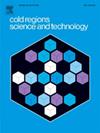The importance of snow microstructure: An analysis of snow compressive strength under high strain
IF 3.8
2区 工程技术
Q1 ENGINEERING, CIVIL
引用次数: 0
Abstract
Understanding the mechanical behavior of snow is critical for many cold regions applications, such as vehicle mobility or avalanche forecasting. Previous studies have used experimental tests and model simulations to look at the impact of snow microstructure on the overall mechanical strength. However, these analyses have not explicitly defined these relationships and few have focused on the brittle regime. We compare the peak stresses of experimental and simulated dry sintered snow samples compressed at a high strain rate to a variety of microstructural parameters and use a linear regression framework to explicitly characterize the relationships between them. We show that the most influential microstructural parameter for characterizing snow strength is the scaled bond contact area between neighboring snow grains, while the least important is the average sintered bond size. We then demonstrate that the influence of sintering time on peak stress varies drastically depending on the grain size of the snow sample, with larger impact found on smaller grain size samples.
雪微观结构的重要性:高应变下雪抗压强度分析
了解雪的力学行为对于许多寒冷地区的应用至关重要,例如车辆移动或雪崩预测。以前的研究使用实验测试和模型模拟来研究雪的微观结构对整体机械强度的影响。然而,这些分析并没有明确定义这些关系,很少有人关注脆性体系。我们将实验和模拟干烧结雪样品在高应变率下压缩的峰值应力与各种微观结构参数进行了比较,并使用线性回归框架来明确表征它们之间的关系。研究表明,表征雪强度最重要的微观结构参数是邻近雪颗粒之间的粘结接触面积,而最不重要的是平均烧结粘结尺寸。然后,我们证明了烧结时间对峰值应力的影响取决于雪样品的晶粒尺寸,并且在较小晶粒尺寸的样品中发现较大的影响。
本文章由计算机程序翻译,如有差异,请以英文原文为准。
求助全文
约1分钟内获得全文
求助全文
来源期刊

Cold Regions Science and Technology
工程技术-地球科学综合
CiteScore
7.40
自引率
12.20%
发文量
209
审稿时长
4.9 months
期刊介绍:
Cold Regions Science and Technology is an international journal dealing with the science and technical problems of cold environments in both the polar regions and more temperate locations. It includes fundamental aspects of cryospheric sciences which have applications for cold regions problems as well as engineering topics which relate to the cryosphere.
Emphasis is given to applied science with broad coverage of the physical and mechanical aspects of ice (including glaciers and sea ice), snow and snow avalanches, ice-water systems, ice-bonded soils and permafrost.
Relevant aspects of Earth science, materials science, offshore and river ice engineering are also of primary interest. These include icing of ships and structures as well as trafficability in cold environments. Technological advances for cold regions in research, development, and engineering practice are relevant to the journal. Theoretical papers must include a detailed discussion of the potential application of the theory to address cold regions problems. The journal serves a wide range of specialists, providing a medium for interdisciplinary communication and a convenient source of reference.
 求助内容:
求助内容: 应助结果提醒方式:
应助结果提醒方式:


